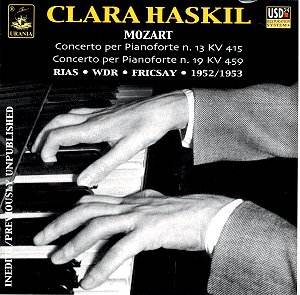These recordings are published for the first
time and I can’t quite make out if they are taken from original
tapes in the Berlin and Cologne radio archives or whether they
are off the air. If the latter is the case, they are very clean
and interference-free. If they are originals then I would have
expected a clearer and less distorted sound – there is much curdling
of tone from both wind and pianoforte in the louder passages –
even considering the date.
The technical limits of the recordings will probably
restrict interest to the pianist’s many admirers, since she recorded
both works later for DG – K.415 with the Bavarian State Orchestra
under Bernhard Paumgartner and K.459 with Fricsay and the Berlin
Philharmonic. She also recorded K.459 for Westminster with the
Wintherthur Symphony Orchestra under Henry Swoboda, but this was
compromised by poor orchestral playing.
However, while those discovering the art of Clara
Haskil will do better to hear the DG recordings, those with a
little patience will find many rewards here. Despite a life ravaged
by illness and personal tragedy, Haskil’s Mozart achieved a calm,
Olympian sublimity which is a locus classicus of one particular
way of playing this composer. You might at first find her undemonstrative,
under-characterised even, yet within the classical limits she
imposes upon herself she misses nothing. And not even these recordings
can disguise the fact that she had a radiantly beautiful tone.
Is she just a little too prim and proper at times? I think not,
but I can only explain the fact that Haskil’s "limitations"
prove to be nothing of the sort while the apparently similar limitations
of an Ingrid Haebler are just that by invoking the very subjective
concept of spirituality. Haskil had something in her which could
move us, and we shall probably never be able to explain this any
more than we can explain why Mozart himself moves us.
I have a query over Fricsay’s handling of the
opening theme of K.459. He has the strings phrase with such a
suave legato that the repeated notes – so smartly rapped out by
George Szell in his classic recording with Rudolf Serkin – almost
seem one single long note. The trouble is that when the theme
comes in the wind and later on the piano, they cannot phrase in
this way and their repeated notes are clear. So I think Szell
was right, and the theme should be phrased in the same manner
whichever instruments are playing it.
Christopher Howell
